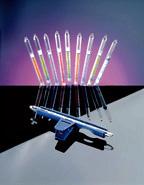| Selection Guide> Gas Detection | |
| Shop for Gas Detection Systems |
How Colorimetric Gas Detection Systems Work |
| e | |
|
Active Systems: Active colorimetric gas detection uses a special manual syringe or battery-operated pump to draw a 100 ml air sample though a special indicator tube. The tube is made of clear glass and contains a crystalline reagent that reacts specifically with the gas of interest--changing color as the gas moves along the reaction column. The higher the gas concentration, the longer the length of the color stain. The easy-to-read measuring scale printed on each tube lets you make convenient, accurate gas measurements in less than 60 seconds. Passive Systems: Dosimeter tubes or dositubes provide an inexpensive way to assess average gas concentrations over short periods of time--say 1 to 8 hours. Dosimeter tubes use an indicator column similar to that of the active systems, but no air pump is employed. Instead, air moves passively through the column over time. Readings taken from the scale on the side of the tube are time dependent--the longer the tube is exposed, the higher the reading. To correct for the time factor, readings are divided by the hours of exposure to yield a time-weighted average. Dosimeter tubes can monitor gas concentration in a specific location or they can worn on lapel clips to monitor employees' exposure to potentially harmful gases over the course their work day.
|
|
| Where are Colorimetric Gas Detection Systems Used? | Features of Colorimetric Gas Detection Systems to Consider | ||
| Top of Page | Any
facility operating under OSHA safety guidelines.
Monitoring employee exposure to potentially harmful gases Checking flue gases and auto emissions Confined space entry procedures Leak detection Manufacturing processes Enclosed livestock facilities Troubleshooting "sick" buildings
|
The
type of gasses you need to measure
Active system (instant readings) or passive system (longer term monitoring). Availability of sampling tubes Measuring range and units of measure (ppm, %, mg/m3, etc.) Measuring precision and accuracy. Measuring specificity, in other words, the ability to screen out similar compounds while detecting just the gas of interest. Pump construction and maintenance needs. |
